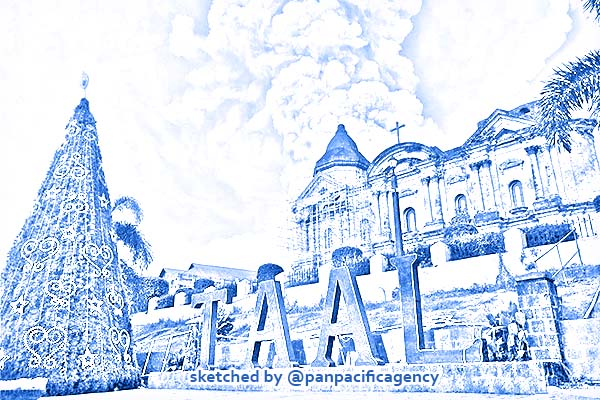Philippine volcano Taal’s fissure vents continue to emit steam

This handout photo taken and received on January 12, 2020 courtesy of Renz Lejarso Guevara shows ash from the Taal volcano (not pictured) in the air, as seen against a church in the foreground in the town of Taal in Batangas province south of Manila. A volcano near the Philippine capital Manila spewed a massive cloud of ash into the sky on January 12, forcing the precautionary evacuation of thousands of residents, authorities said. AFP/Courtesy of Renz Lejarso Guevara/Handout. Sketched by the Pan Pacific Agency.
MANILA, Feb 9, 2020, PhilStar. Fewer volcanic earthquakes were recorded around Taal Volcano even as steaming from the main crater and fissure vents on a trail on the volcano island were observed again yesterday, The Philippine Star reported.
The Philippine Institute of Volcanology and Seismology (Phivolcs) said the fissure vents along Daang Kastila, an almost three-kilometer trail leading to the main crater, emitted weak steam.
The fissures on the trail appeared only last month.
The Taal Volcano Network recorded 115 volcanic earthquakes yesterday compared to 118 on Friday.
Moderate emission of white to dirty white steam-laden plumes that rose 200 to 300 meters and drifted southwest was also observed. Sulfur dioxide emission was measured at an average of 54 tons per day.
Alert level 3 remains
Phivolcs said Alert Level 3 remains in effect over the volcano.
It warned the public that sudden steam-driven and weak phreatomagmatic explosions, volcanic earthquakes, ashfall and lethal volcanic gas expulsions could still occur and threaten areas within the volcano island and nearby lakeshores.
Phivolcs said entry into the island and areas around Taal Lake within the seven-kilometer radius from the main crater is strictly prohibited.
“Local government units are advised to assess areas outside the seven-kilometer radius for damage and road accessibilities and to strengthen preparedness, contingency and communication measures in case of renewed unrest,” the agency said.
The public should observe precautions due to ground displacement across fissures, frequent ashfall and minor earthquakes, it added.
Phivolcs said residents near active river channels, particularly where ash from the main eruption were thickly deposited, should increase vigilance during heavy rainfall due to the threat of lahar.